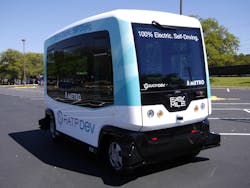Connected buses can serve as the foundation for any municipality’s smart city blueprints. The technology exists today to improve the rider experience, reduce traffic congestion and lessen the impact a fleet of buses has on the environment. Even more beneficial technologies are on the near horizon. These systems all have one thing in common: they connect to the Internet (and one another) to generate and share enormous volumes of data. The challenge for mass transit officials is turning that raw data into useful information.
Make that two things they have in common: they all need a tangible benefit. That requires mass transit operators to be able to explain the benefits of making strategic investments to two key audiences: city officials and the public. Fortunately, it’s becoming increasingly likely that both groups will embrace a connected bus system as part of the larger whole that is the connected smart city.
The U.S. Census Bureau reports that all but one of the nation’s 20 largest cities in 2015 saw their populations grow at an average rate that was almost double that of the previous decade. These new arrivals don’t just want to enjoy the traditional benefits of city life. They expect their municipalities to leverage technology to improve the efficiency of services, reduce traffic headaches and improve the overall quality of life. But creating a smart city is a complex and expensive undertaking. The key is to break the project down into phases, starting with mass transit systems.
Mass transit operators are no stranger to launching public relations and marketing campaigns leading up to Election Day that ask for “yes” votes for referendums that call for allocating tax dollars to fund transit system improvement projects. When it comes to garnering public support for creating a connected bus system, the time frame will be much longer than the typical election season. New technologies will be added on an incremental basis, so it will be easier to maintain public support with a “rolling thunder” marketing effort over a series of individual stand-alone campaigns.
Convincing municipal officials who hold the city’s purse strings to support connected bus systems may prove to be easier than garnering widespread public support. They want to turn their smart city visions into reality, and as a recent report from Juniper Research, “Worldwide Smart Cities: Energy, Transport & Lighting 2016-2021” shows, focusing on making mass transit smarter is critical.
“Congestion and mobility are almost universal issues for cities to address,” noted the report’s author Steffen Sorrell. “Facilitating the movement of citizens within urban agglomerations via transport networks is fundamental to a city’s economic growth. When addressed effectively, the impacts are substantial: higher economic productivity, potential for new revenue streams and services as well as a measurable benefit in reduced healthcare costs.”
A Vision for Connected Buses
To get an idea of why experts consider smart mass transit systems so important to the long-term viability of a smart city, picture this scenario: An entire fleet of connected buses that not only offers riders free Wi-Fi access, but also provides them with real-time alerts on arrival and departure times via text message or a smartphone app. Thanks to partnerships with the business community, riders can also receive location-aware offers from restaurants and stores that will be within walking distance of their bus stops. Meanwhile, GPS devices on-board each bus connect with sensors in traffic lights to trigger green lights as buses approach, while engine performance monitoring systems send provide maintenance staff with up-to-date status reports and alerts.
Sounds like a hopeful vision for the future, but that vision will soon become reality — and in some cases already is.
Turning Vision into Reality
More buses equipped with Wi-Fi and other technologies to improve the rider experience are hitting the streets nationwide. For example, the New York City Mass Transit Authority last year began rolling out new connected buses as part of its commitment to equip 2,042 buses with Wi-Fi hotspots by 2020. In addition to Wi-Fi access, the buses offer USB ports and digital information screens that display everything from automated stop announcements, available transfers at each stop, news, weather and advertising, and real-time communication from the MTA.
Las Vegas recently partnered with car maker Audi to develop a system that shows drivers how long they'll have to wait for the next stoplight to change. It's the first Vehicle-to-Infrastructure technology to go live in the United States, and shows what’s possible for cars, buses and other transportation systems. For example, the system could automatically cut the engine off and on to reduce idling time, saving gas, money and the environment. It could also link to a vehicle’s GPS navigation system to optimize routing decisions.
You’ve likely heard or read a lot lately about the development of autonomous vehicles, and that trend includes connected buses. Capital Metro in Austin, Texas recently gave riders a demonstration of its EasyMile EZ10 fully autonomous shuttle. The 12-passenger, all-electric EZ10 ran on pre-determined routes on a closed course on The University of Texas at Austin campus. The demonstration showed how Capital Metro is exploring new ways to move people around Austin while helping to reduce emissions.
Collecting Data Is Just a First Step
Those are just three examples of why investing in connected bus systems is becoming a necessity, not an option. Because these systems collect ever-growing volumes of data, mass transit authorities’ budgets should also allocate for the hiring of professionals who can install and maintain these technologies, as well as analyze the data that comes streaming in from them every day.
Collecting data is the easy part. The heavy lifting comes with taking data and turning it into information. Systems can provide statistics on ridership, route scheduling, and vehicle maintenance, but they require human intervention to identify opportunities to drive change and improvements.
Blaine Rigler is the president of McDonald Transit Associates and VP of Bus Services for RATP Dev North America.
About the Author

Blaine Rigler
President
Blaine Rigler is the president of McDonald Transit Associates and VP of Bus Services for RATP Dev North America, one of the largest multimodal transit operators in the world. Rigler, along with McDonald Transit, is based in Fort Worth, Texas.
